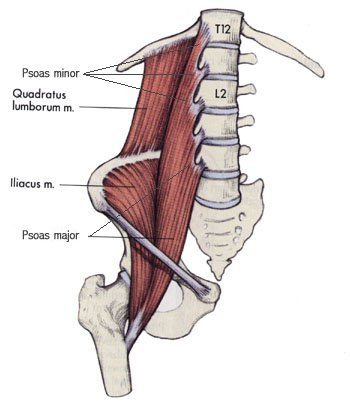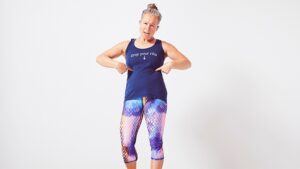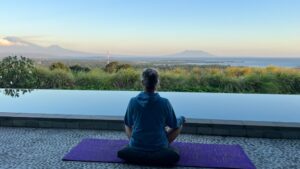UPDATED: April 30, 2025
Have you ever heard of your psoas muscles? For many people, the first time they hear the word psoas is when their massage therapist tells them that theirs are really tight. And that their tight psoas is probably related to their back pain. Or their hip pain. Or their knee pain. Or whatever.
Even though these muscles are deep and not well known, they’re kind of a big deal for your whole body wellness. So I’m here today to introduce you to these fascinating muscles and give you one of my absolute favourite exercises to help get them working at their best.
Where Are The Psoas Muscles?
The psoas muscles are a major part of the reason your legs are attached to the rest of you. They connect to your spine, at the bottom of your ribcage, and then descend down your back, attaching at multiple points – including the vertebral discs – along the way, until they pass through the pelvis and arrive at their final attachment on the femur bones – the big long bones of the thighs.
Here’s a picture:

So this is a big deal because attaching in so many places means that when the psoas muscles aren’t working right, they can mess you up in a whole lot of places.
What’s The Problem With A Tight Psoas?
Modern lives lead to short psoas muscles – sitting, standing with the pelvis forward, standing with the knees bent, high anxiety and stress levels (they’re part of the body’s trauma protection mechanism), common sports and fitness-related movement patterns and ‘good posture’ that involves rib thrusting.
Short, tight psoas muscles may contribute to back issues, knee problems, hip and SI joint pain, pregnancy and birth issues, and digestive trouble.
Where you have an issue will depend on your individual movement patterns.
My own psoas muscles tend to operate primarily on my rib cage, making it hard for me to keep my ribs dropped (and my left is tighter than my right).
Other people will find that their psoas muscles pull their femurs forward into hip flexion – this can be one reason it’s hard to release your knee caps. And still others may find that their psoas muscles are causing them both to rib thrust and to hip flex. Only one thing is sure – if you’re a modern North American, you’re probably operating with a less-than-optimal psoas muscle arrangement.
Start healing your pelvic floor, building a functional core & caring for your spine (for free!)
How Can I Change My Psoas Tension?
In this case, stretching them alone won’t fix the problem – you need to release your psoas muscles.
What’s the difference between a stretch and a release? Think about clenching your hand into a fist, as tight as possible. Now, without letting go, imagine what would happen if you tried to stretch your fingers. You’d have a war, right? Between the clenching and the stretching. If you really want to stretch, first you have to release your fist so your fingers relax. Same thing here – before you can stretch, you must release. Boom.
Disclaimer – this is either the easiest or the hardest exercise you will ever do. If you find it incredibly hard to lie still long enough for this, if you feel like you’re not ‘doing’ anything, and if you feel like it’s a waste of time, then this is probably extra important for you, because you are probably just a touch Type A and so you need to take time for focused relaxation more than anyone else. Don’t worry – once you have released your psoas muscles there are some good stretches waiting for you – plus your walking will be already a million times better – so your time will not be wasted and you’ll get to do some nice intense things soon.
The Wonderful, Delicious, Psoas Release
So the release is really quite simple.
All you’re going to do is find a bolster (best) or a firm cushion or rolled up sleeping back or whatever you have that will hold your head and shoulders up in the air.
How high? If your hamstrings came up off the ground, bolster yourself at the point where they rose up. If they didn’t, start by giving yourself 5-8 inches of bolstering and see how that works for you. You’re going to lie down with the bolster under your head and shoulders. The edge should be right around the bottom of the shoulder blades (the bra strap, the bro strap, or the spot where you’d wear a heart rate monitor).
There’s no real magic to it though – you should be well supported but your ribs should have enough room to relax down to the ground.
And that’s it.
Now you’re going to chill out here – without a podcast, television, audiobook, music or other form of entertainment (all of which can excite the psoas and make them hard to release).
You’re going to consciously think about the back of your body melting into the ground – but you’re not going to muscle it down, just allow it to get there naturally.
It can be helpful to put a nice warm heavy folded blanket onto your lower ribs. Rest there for 5-10 minutes or so – you can do more if you like, and you can also stay there until you actually notice your psoas muscles release completely (however you may not notice this happening – so doing this for time may be easier).
This is a great thing to do before bed – it’s very relaxing – but also before you go for a walk, since you want your psoas muscles nice and supple during gait.
Pretty much everyone needs this, on a daily basis! I used to hate having to lie there and do nothing, and now it is one of my favourites (and only takes about 2 minutes, as my psoas muscles are now well trained!). Give it a try and let me know how it goes for you!
FYI, one thing a tight psoas muscle will do is pull your low ribs forward, which can be hard on your pelvic floor, low back and hips. To assess whether this is happening in your body, make sure to check out my FREE 5 part video series, Ribcage Magic. I’ll walk you through why ribcage position is super important, how to do a quick self-check of your own ribcage alignment and help you find the ideal rib position. Doing lots of psoas release will help most people get their ribs down with more ease, so grab your cushions and start relaxing!







